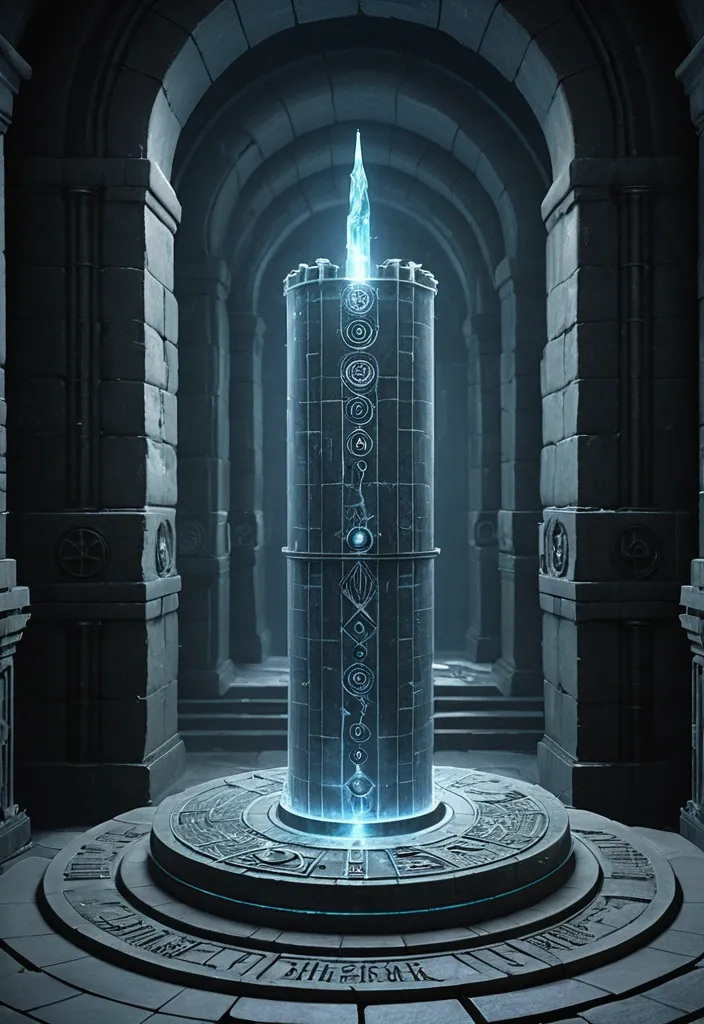Search Results for orb
Explore AI generated designs, images, art and prompts by top community artists and designers.

Ultra-realistic cinematic sequence. Aerial shot , extreme vertical view of a camera orbits at 90 degrees , a high-tech spacecraft uniquely Orange text "R" shaped , a female pilot sitting in the glass cockpit , flying over ocean landscape covered in shimmering silver glitter , bathed in a Aurora as the Northern Lights and dark black palette. Science fiction influences , 32K UHD , atmospheric installations , otherworldly visions , fluorescent colors , ethereal glow , futuristic aesthetics. ,

A futuristic vision of a fusion of Escher and Dali styles made of Tendrils , a zero-gravity transit hub city inside a Dyson Sphere orbiting a blue giant star. This city coordinates the flow of interstellar travelers and materials. All structures are formed by dynamic gravitational fields , and transportation is enabled via quantum entanglement teleporters. Civilization laws are enforced by sentient time-dilation fields , high depth cinematic detail , (ultra-detailed) , imaginative composition , enchanting atmosphere , full illusion , captivating. ,

arthub.ai{"Name": "Xander Phillips" , "Phone": "055 6560 3327" , "Mail": "nisl@enim.co.uk" , "Company": "Elit A Feugiat Consulting"} , {"Name": "Elton Benjamin" , "Phone": "0912 107 4176" , "Mail": "in.consectetuer@famesacturpis.org" , "Company": "Amet Massa Quisque Corporation"} , {"Name": "Victor Pruitt" , "Phone": "055 9771 6292" , "Mail": "diam@Proindolor.org" , "Company": "Mi Lorem Corp."} , {"Name": "Lyle Lloyd" , "Phone": "07078 577451" , "Mail": "neque@semut.com" , "Company": "Facilisis Incorporated"} , {"Name": "Acton Rosa" , "Phone": "0321 973 5347" , "Mail": "vehicula@Cras.ca" , "Company": "Nullam Incorporated"} , {"Name": "Garrison Holman" , "Phone": "0845 46 46" , "Mail": "Morbi@orci.net" , "Company": "Tortor Nibh Sit LLC"} , {"Name": "Dexter Holman" , "Phone": "0845 46 48" , "Mail": "erat@turpis.co.uk" , "Company": "Amet Ltd"} , ,

A vaulted greenhouse nestled against the clocktower’s upper terrace , its glass panes framed by black iron ribs and brass filigree. Inside , lush greenery glows under suspended crystal orbs that mimic daylight , bathing rows of plants in soft golden light. Long stone planters overflow with herbs — moonbell , feverroot , duskfern — each tagged with neat , handwritten runes. Copper irrigation pipes snake along the walls , hissing faintly as mist rises from hidden vents. A central worktable holds mortar sets , potion flasks , and a small arcane cauldron shaped like a lotus. In the corner , Orwen’s botanical apprentice tends to a vine with metallic leaves that hum faintly when brushed. The space feels equal parts botany and enchantment laboratory , with steampunk glass instruments and living magic entwined. Lighting: soft warm gold with shafts of filtered sunlight. Camera: mid-angle from the entrance , capturing layered rows of plants and the glowing mist. Style: semi-realistic digital painting , painterly textures , serene but arcane tone. ,

wide horizontal composition , landscape orientation , cinematic widescreen format , 16:9 aspect ratio , panoramic view , elderly woman with silver braid standing at wooden table , traditional rustic room at night , moonlight through window , candlelight illumination , twelve white candles in ceramic holders , two parallel rows , crystal vase with twenty one eggs , three stacked bread loaves , wooden bowl with poppy seeds , sea salt in ceramic dish , woman reading handwritten book , hand hovering over ritual items , wooden icon on wall , simple wooden chair , textured plaster walls , aged wooden floorboards , doorway perspective view , silvery moonlight path , golden candlelight glow , window frame shadows forming cross pattern , floating dust motes like stars , dark blue woolen dress and shawl , stunning environment , dusk lighting , ultra detailed , intricate detail , volumetric lighting , vivid colours , photorealistic , photography , lifelike , high resolution , digital art , doorway view , interior perspective , wallpaper , wide angle lens , horizontal framing ,

A slender , graceful vampire , appearing in her late 20s to early 30s with dark skin , long dark dreadlocks , and striking eyes with a subtle reddish hue , kneels in fear as she is judged and incriminated for her forbidden love. The scene is rendered in a graphic novel style , with bold lines and dramatic shadows , reminiscent of Artstation illustrations. An imposing vampire sits on a throne-like structure , positioned higher in the frame , pointing and shouting at her. The other vampires surround her , their expressions condemning. The overall color palette is dark and oppressive , with muted blues , purples , and blacks dominating , emphasizing her vulnerability and the severity of the situation. ,

A slender , graceful vampire , appearing in her late 20s to early 30s with dark skin , long dark dreadlocks , and striking eyes with a subtle reddish hue , stands alone , surrounded by other vampires , facing threats due to her forbidden romance. The scene is rendered in a graphic novel style , with bold lines and dramatic shadows , reminiscent of Artstation illustrations. The atmosphere is dark and menacing , with deep shadows obscuring the faces of the surrounding vampires. Their expressions are cold and hostile. The overall color palette is muted , with dark blues , purples , and blacks dominating , creating a sense of danger and isolation. ,

A slender , graceful vampire , appearing in her late 20s to early 30s with dark skin , long dark dreadlocks , and striking eyes with a subtle reddish hue , stands alone , surrounded by other vampires , facing threats due to her forbidden romance. The scene is rendered in a graphic novel style , with bold lines and dramatic shadows , reminiscent of Artstation illustrations. The atmosphere is dark and menacing , with deep shadows obscuring the faces of the surrounding vampires. Their expressions are cold and hostile. The overall color palette is muted , with dark blues , purples , and blacks dominating , creating a sense of danger and isolation. ,

"A strong , imposing figure stands on a rooftop , back to the viewer , gazing intently at the moon. The scene is rendered in a graphic novel style , with bold lines and dramatic shadows. He has his hands in his pockets , dressed in casual evening wear. His dark skin is subtly illuminated by the city lights below , hinting at his muscular build. His dreadlocks are visible even in silhouette , cascading down his back. His entire posture conveys a sense of longing and contemplation directed solely at the moon above. The city lights twinkle below , but his undivided attention is fixed on the lunar orb , which casts a soft glow on his back. The overall color palette is rich and saturated , with deep blues , purples , and reds dominating , creating a sense of solitude and longing. His piercing eyes , though unseen , possess a wolf-like coloration , adding to his imposing presence." ,

"A strong , imposing figure stands on a rooftop , back to the viewer , gazing intently at the moon. The scene is rendered in a graphic novel style , with bold lines and dramatic shadows. He has his hands in his pockets , dressed in casual evening wear. His dark skin is subtly illuminated by the city lights below , hinting at his muscular build. His dreadlocks are visible even in silhouette , cascading down his back. His entire posture conveys a sense of longing and contemplation directed solely at the moon above. The city lights twinkle below , but his undivided attention is fixed on the lunar orb , which casts a soft glow on his back. The overall color palette is rich and saturated , with deep blues , purples , and reds dominating , creating a sense of solitude and longing. His piercing eyes , though unseen , possess a wolf-like coloration , adding to his imposing presence." ,

"A strong , imposing figure stands on a rooftop , back to the viewer , gazing intently at the moon. The scene is rendered in a graphic novel style , with bold lines and dramatic shadows. He has his hands in his pockets , dressed in casual evening wear. His dark skin is subtly illuminated by the city lights below , hinting at his muscular build. His dreadlocks are visible even in silhouette , cascading down his back. His entire posture conveys a sense of longing and contemplation directed solely at the moon above. The city lights twinkle below , but his undivided attention is fixed on the lunar orb , which casts a soft glow on his back. The overall color palette is rich and saturated , with deep blues , purples , and reds dominating , creating a sense of solitude and longing. His piercing eyes , though unseen , possess a wolf-like coloration , adding to his imposing presence." ,

Hidden below the ground floor , accessible only through Butler’s ledger-key and Orwen’s sigil. A narrow spiral leads to a cylindrical chamber lined with runic cages — each section holds relics under stasis light. The Disc containment pedestal rests at the center: six radial slots , three filled. The air hums faintly , charged but serene. Between the pedestals , a narrow walkway of black glass reveals a cooling pool of enchanted quicksilver — the tower’s failsafe absorber for unstable magic. At the far wall , a crystal status console records artifact resonance in real time , flickering with dwarvish script from Karadum’s old system. Lighting: cool silver , motionless. Sound: steady heartbeat-like thrum. Mood: sacred science — a sanctum where power is respected , not displayed. ,

A fortified circular hall deep within the clocktower’s core , designed for testing and tempering magical artifacts. The walls are lined with engraved runic plates and pivoting bronze mirrors , each capable of redirecting spell energy. A reinforced obsidian floor etched with concentric containment rings marks the testing area’s center. Suspended sigil projectors hover above like chandeliers , forming shifting shields of light when activated. Training dummies made of wood , steel , and enchanted clay stand ready , some half-shattered from previous trials. Along the far wall , a rack of prototype weapons and spell-foci glimmers under torchlight — Orwen’s unfinished experiments. When spells are cast here , energy disperses through glowing conduits in the ceiling , absorbed by humming arcane capacitors. Lighting: high-contrast gold and blue , faint sparks in the air. Camera: wide shot from the balcony overlooking the testing circle. Style: semi-realistic fantasy artwork , metallic gleam , dynamic tension , warm-meets-cool light palette. ,

A vaulted greenhouse nestled against the clocktower’s upper terrace , its glass panes framed by black iron ribs and brass filigree. Inside , lush greenery glows under suspended crystal orbs that mimic daylight , bathing rows of plants in soft golden light. Long stone planters overflow with herbs — moonbell , feverroot , duskfern — each tagged with neat , handwritten runes. Copper irrigation pipes snake along the walls , hissing faintly as mist rises from hidden vents. A central worktable holds mortar sets , potion flasks , and a small arcane cauldron shaped like a lotus. In the corner , Orwen’s botanical apprentice tends to a vine with metallic leaves that hum faintly when brushed. The space feels equal parts botany and enchantment laboratory , with steampunk glass instruments and living magic entwined. Lighting: soft warm gold with shafts of filtered sunlight. Camera: mid-angle from the entrance , capturing layered rows of plants and the glowing mist. Style: semi-realistic digital painting , painterly textures , serene but arcane tone. ,

A crystal crescent moon cradles a lone fisherman sitting on its curve at middle of sky , holding a fishing rod as gentle clouds surround him , streets lit by flying orbs of light. Stylized clouds curl around it like decorative filigree. Rendered in digital Art Nouveau fusion style with flowing lines , luminous gradients , and a refined , dreamlike atmosphere. ,

A 62 years old woman of sublime sensuality. She reclines languidly on a deep black leather armchair , in a room draped with dark velvet walls that absorb the surrounding light.Her body is partially veiled by a delicate white silk saree shroud , sheer and fluid , which clings to her curves like a dusky skin. The fabric reveals and conceals at once — slipping from her shoulder , tracing her silhouette with suggestive elegance. Beneath this veil , her skin glows with warm golden highlights , adorned with fine jewelry — bracelets , earrings , and a subtle golden necklace shimmering like fragments of captured sunlight.Camera ,

A 62 years old woman of sublime sensuality. She reclines languidly on a deep black leather armchair , in a room draped with dark velvet walls that absorb the surrounding light. Her body is partially veiled by a delicate white silk saree shroud , sheer and fluid , which clings to her curves like a dusky skin. The fabric reveals and conceals at once — slipping from her shoulder , tracing her silhouette with suggestive elegance. Beneath this veil , her skin glows with warm golden highlights , adorned with fine jewelry — bracelets , earrings , and a subtle golden necklace shimmering like fragments of captured sunlight. Camera & Render: Boudoir editorial photography , 50mm f/1.2 , shallow focus , ultra-detailed textures of silk , jewelry , skin and leather , cinematic golden chiaroscuro , 8k hyperrealism. ,

A massive polygon completely encircling the polygon , with intricate cross-sectional details revealing sprawling human settlements , alien architecture , organic architecture , porcelain , Eco-friendly , bibliophile and interconnected skyscraper structures visible through the polygon's translucent exterior. Hyper-detailed architectural. Rotating rail-track in space with artificial gravity. 30th century orbital cars running on polygon-track , motion speed , advanced technological networks. Cinematic composition highlighting the monumental engineering achievement , using crisp photographic realism and a color palette of metallic silvers. Ultra-high resolution rendering with microscopic precision and grand astronomical perspective. ,











